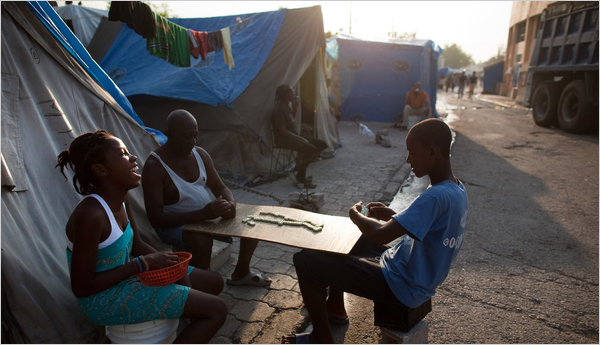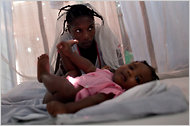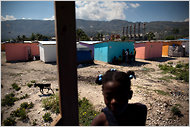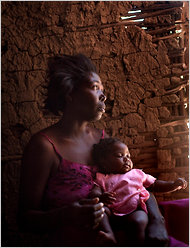After being evicted from a tent camp a few months ago, he, his wife and their three children crammed into a rebuilt home the size of a small U-Haul trailer. But at least a roof shelters their heads, even if a flimsy one that allows the rain to pour through.
“It is made of cheap cement,” Mr. Darvin said, pointing to fresh cracks in the walls. He sounded at once relieved at having found a place and fretful over what another earthquake or hurricane might do to it. “If you think too much about it, you lose your mind.”
More than half of the Haitians driven into tent cities and makeshift camps by the January 2010 earthquake have moved out of them, officially bringing down the displaced population to 680,000 from a peak of 1.5 million, according to the International Organization for Migration.
But what may seem like a clear sign of progress, officials warn, is also a cause of concern.
Very few of the people who left the camps — only 4.7 percent, by the group’s estimate — did so because their homes had been rebuilt or repaired. Instead, a vast majority appear to have been forced out through mass evictions by landowners, or to have left the camps on their own to escape the high crime and fraying conditions there.
Now, most of the former camp dwellers are doubled up in their friends’ or families’ homes, scattered at random in tents and improvised dwellings, or living in “precarious housing” that is dilapidated, damaged or partly collapsed, the organization says. In some cases, the cinder blocks that were toppled by the quake are being cobbled together to make walls again, only more unevenly and wobbly than before.
Dugary St. Jean, 29, said he left a downtown camp in November with his pregnant wife to return to Fort National, a hilly neighborhood east of downtown with row after row of crumbled houses. At the camp, they often heard gunshots. They were robbed. Finally, they decided their baby, now 6 weeks old, would be safer almost anywhere else.
They packed up their tent and headed to the house of a family friend. It is heavily damaged but has a small, spare room where Mr. St. Jean, his wife and their baby now live — along with his mother and nephew. “I survive day after day thanks to others,” he said.
Giovanni Cassani, a coordinator with the migration organization, said the mass departures from camps made it harder to track and help people, complicating treatment and prevention of a cholera epidemic that has killed nearly 5,000 people since October. “Those returning to unsafe conditions risk falling off the radar because they are much more difficult to find and assist,” Mr. Cassani said. “And all those still in the camps, the more than 600,000 with no housing solution, they are the most difficult caseload.”
Priscilla Phelps, a senior adviser at the Interim Haiti Recovery Commission, the panel that is developing reconstruction plans, said disputes over land ownership and delays getting money had kept much housing, beyond sporadic projects, from getting off the ground. “We are putting all the information together,” she said. “But we do not have a plan with numbers in it.”
Only about 37 percent of the more than $5 billion pledged last year by foreign governments and international agencies has been disbursed to the Haitian government, the Haiti reconstruction fund, nongovernmental organizations or other entities, according to the United Nations.
Diplomats have complained of red tape in Haiti and the uncertain outcome of last year’s chaotic presidential election, which was finally resolved when a popular singer, Michel Martelly, prevailed in a runoff in March. He takes office in May, and has pledged to speed things up.
The Haitian government, in turn, has said that some 10,000 nongovernmental groups have failed to coordinate with them, slowing project approvals.
As the delays have continued, waves of people have left the camps, often with nowhere to go. In a survey of 1,033 residents from 22 dismantled camps, the migration group found that evictions accounted for the largest share of departures, about 34 percent. But high crime (13.6 percent), poor conditions (13.9 percent) and the threat of rain or hurricanes (16.4 percent) also took a toll.
Hundreds of camps have disappeared entirely; there are 1,061 now, down from a peak of 1,555 in July.
One of the more striking examples — a jumble of more than 300 tents and lean-tos perched precariously along the thin median of a six-lane road — was dismantled in January after officials found space nearby for transition shelters housing 180 families.
The plywood shelters, painted in a kaleidoscope of pastels in an industrial zone, are meant to be temporary, lasting three to five years. More than 100,000 such transition shelters were to be built in Haiti, but less than half of them have been finished, hung up largely by the slow pace of removing the rubble that still lines many streets and by the difficulties in finding land and financing.
But even in this step-up from a tent, residents do not rest easy.
“We have been relocated, yes, but the situation is the same,” said Michellange Bourdeau, 38. “In the middle of the road others could see us, but where we are now, no one can see us and come to help. We are the forgotten.”
Aid groups have walked a line between providing necessities like food and water and worrying that steady services would help turn the camps into more permanent shantytowns. Already, several camps sport barbershops, nightclubs and markets.
Still, the camps are often woefully inadequate. Last week, 53 members of Congress urged the Obama administration to help, arguing that 38 percent of camps lacked regular water supplies. Nearly a third do not have toilets, they said. Where toilets are provided, each one is shared by an average of 273 people.
And it is getting harder to stay in the camps, whether because people are forced off the land or because they are tugged by the pull of home. Or both.
When Marie Nicoles Méus and her four children were evicted from a camp in January, they moved into a mud-walled shack that her brother had built for his own family.
It is down a garbage-strewn trail, but even with mosquito swarms, flooding, stifling heat and cramped quarters shared with a friend and her baby, Ms. Méus takes comfort in being close to relatives.
“I am worried,” she said of the coming storms of the rainy season. “But I have faith in God.”




